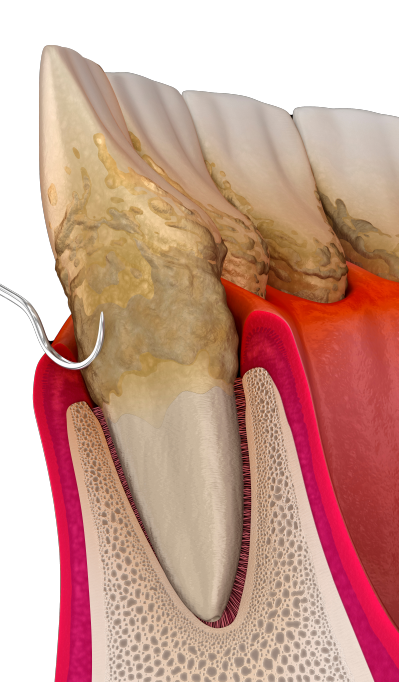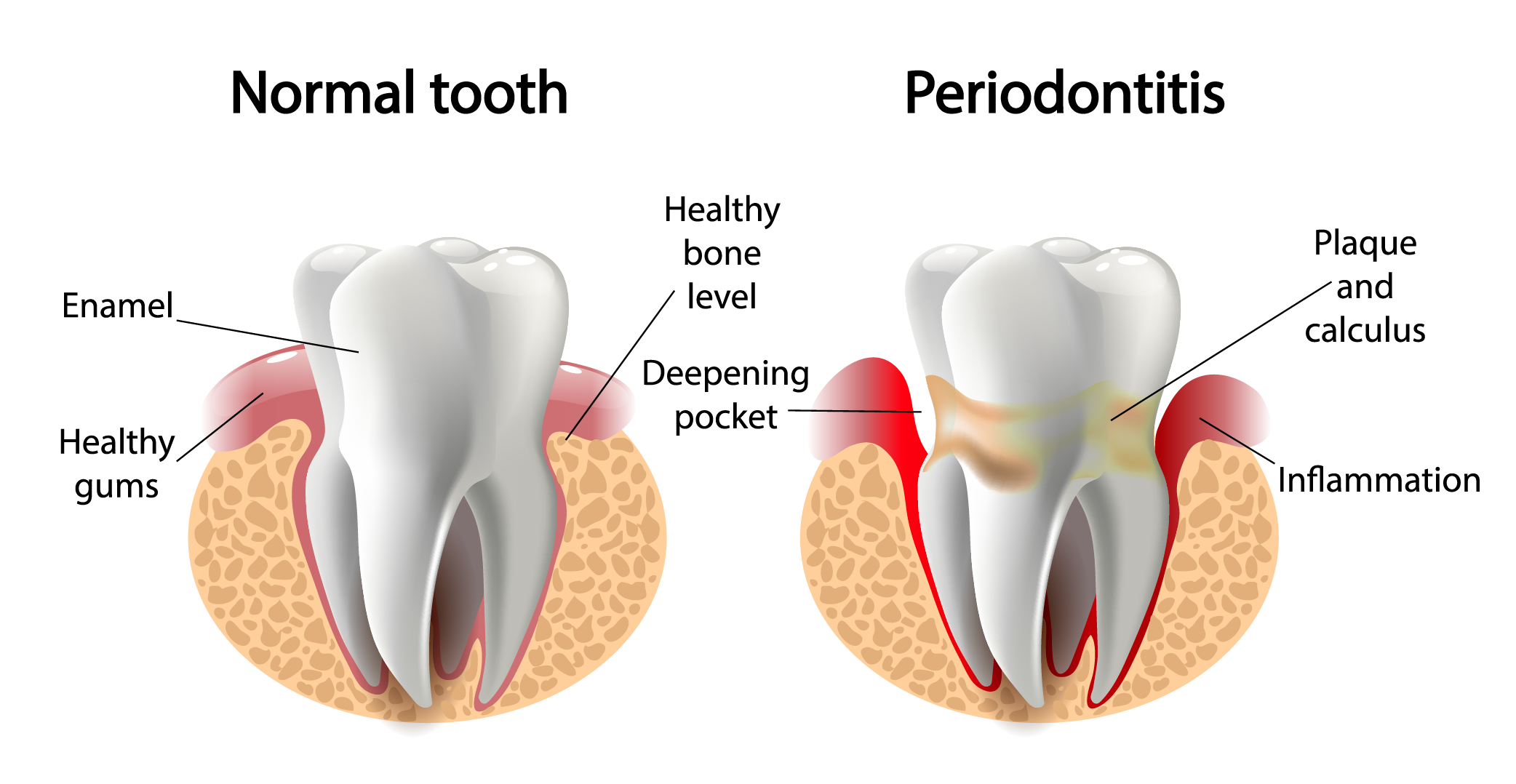Periodontal Disease Treatment in Memphis TN
OR CALL (901) 761-3770
New & Existing
Patient Forms
PHone
(901) 761-3770
Address
6268 Poplar Ave.
Memphis, TN, 38119
1122 Poplar View Ln N
Collierville, TN 38017

What is Periodontal Disease?
Over time, irritated gums pull away from the teeth, forming pockets that allow bacteria to gain a foothold. This causes further irritation, and the pockets deepen as the gum tissue becomes diseased and shrinks further. Eventually, teeth can become loose as the supporting bone in the jaw becomes infected and begins to dissolve.
A patient is considered to have advanced periodontal disease when the pockets are extremely deep, infection is almost constant, and tooth loss has begun. As teeth fall out, the supporting structure of the arch is destroyed, leading to the gradual loss of adjacent teeth. The bone of the jaw continues to deteriorate, and eventually, the patient may become edentulous (toothless).
Understanding the Stages of Gum Disease
- Gingivitis: The earliest stage of gum disease, gingivitis, is characterized by inflammation of the gums. Common symptoms include redness, swelling, and bleeding during brushing or flossing. At this stage, the damage is still reversible with proper oral hygiene and professional cleanings.
- Early Periodontitis: If gingivitis is not treated, it can progress to early periodontitis. This stage involves minor bone loss around the teeth. Symptoms include increased gum bleeding, slight gum recession, and pockets beginning to form between the teeth and gums.
- Moderate Periodontitis: As the disease advances, more bone and tissue damage occurs. Pockets between the gums and teeth deepen, and symptoms such as gum recession, swelling, and bleeding become more pronounced. Tooth mobility may also start to become noticeable.
- Advanced Periodontitis: In the most severe stage, the damage includes significant bone loss, deep periodontal pockets, and potentially loose or lost teeth. Chronic bad breath and pus between the gums and teeth are common. Without intervention, the teeth and supporting structures continue to deteriorate.
Do I have Gum Disease?
- Bad breath (halitosis)
- Sensitivity and/or bleeding of the gums when brushing or flossing
- Gums shrinking away from the teeth
- Red, irritated, or swollen gums
However, periodontal disease can exist and spread even when no obvious symptoms are present. A periodontist can check for gum disease by examining your gums and teeth, looking for calculus (tartar) below the gumline, and measuring the depth of periodontal pockets – the space between the gum and the tooth it surrounds.
The Importance of Regular Dental Checkups
Regular dental checkups are essential in preventing and managing periodontal disease. During these visits, your dentist or periodontist can:
- Conduct thorough examinations to detect early signs of gum disease
- Remove plaque and tartar buildup through professional cleanings
- Measure the depth of periodontal pockets to monitor disease progression
- Provide personalized oral hygiene instructions to maintain gum health
By attending regular checkups, you can catch gum disease in its earliest stages, when it is most treatable and reversible.
Treatment Options for Periodontal Disease
- Professional Cleanings: For early-stage gingivitis, regular professional cleanings can remove plaque and tartar buildup, preventing the progression of gum disease.
- Scaling and Root Planing: This non-surgical deep cleaning procedure involves removing plaque and tartar from below the gumline and smoothing the root surfaces to promote healing and reattachment of the gums to the teeth.
- Antibiotic Therapy: In cases of infection, antibiotics can be applied directly to the periodontal pockets or taken orally to reduce bacterial growth and inflammation.
- Surgical Treatments: For advanced periodontitis, surgical interventions may be necessary. These can include osseous surgery to remove tartar deposits in deep pockets, bone grafts to restore lost bone, and tissue regeneration procedures.
- Laser Periodontal Therapy: This minimally invasive treatment uses laser technology to remove diseased tissue and bacteria, promoting healing and reducing pocket depths.
Preventing Periodontal Disease
- Brush and Floss Regularly: Brush at least twice daily and floss once a day to remove plaque and food particles from between your teeth and along the gumline.
- Use Antimicrobial Mouthwash: An antimicrobial mouthwash can help reduce bacteria and prevent plaque buildup.
- Eat a Healthy Diet: A balanced diet rich in vitamins and minerals supports overall oral health. Avoid sugary and acidic foods that can contribute to plaque formation.
- Avoid Tobacco: Smoking and other tobacco products increase the risk of gum disease and complicate its treatment. Quitting tobacco can significantly improve your gum health.
- Regular Dental Visits: Schedule dental checkups and cleanings every six months to monitor your gum health and receive professional care.
The Link Between Periodontal Disease and Systemic Health
- Cardiovascular Disease: Inflammation and bacteria associated with periodontal disease may increase the risk of heart disease and stroke.
- Diabetes: Gum disease can make it more challenging to control blood sugar levels, and people with diabetes are more susceptible to infections, including periodontal disease.
- Respiratory Infections: Bacteria from the mouth can be inhaled into the lungs, leading to respiratory infections such as pneumonia.
- Pregnancy Complications: Pregnant women with periodontal disease are at higher risk for preterm birth and low birth weight.


